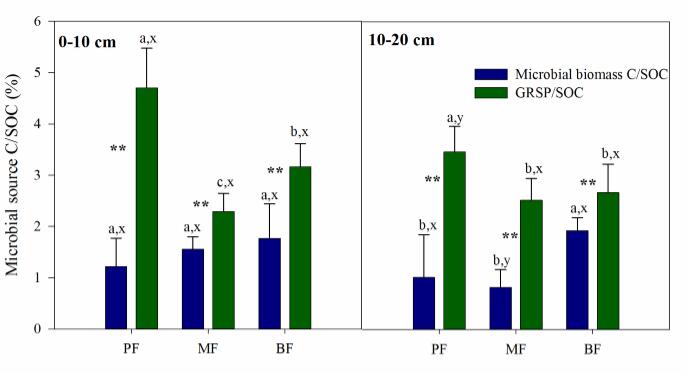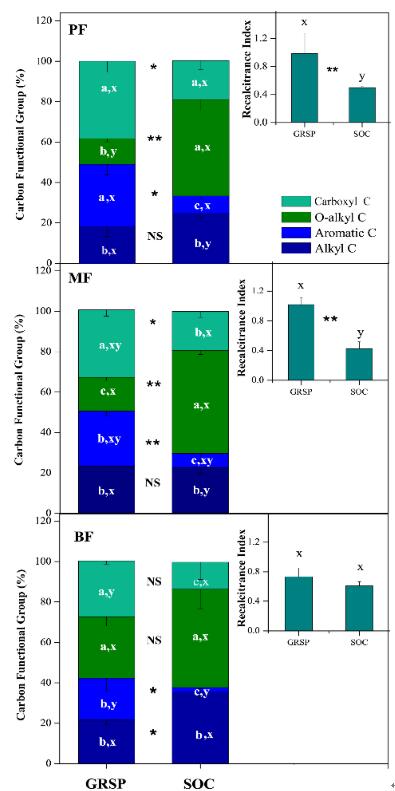Glomalin-related soil protein (GRSP) is recalcitrant glycoprotein, which is known as an important microbial by-product and crucial for preserving or accumulating soil organic carbon (SOC). However, the underlying mechanisms are not well understood.
Ph.D. student Jing Zhang with her supervisor Xuli Tang, from South China Botanical Garden Chinese Academy of Sciences, investigated the chemical structures of GRSP and its relationship with SOC using 13C nuclear magnetic resonance (NMR) in three tropical forests. The three forests, including a planted forest (PF), a secondary forest (MF) and a primary forest (BF), were selected to represent the natural successional process after disturbance in southern China. Results showed that the average concentrations of GRSP were (3.94±1.09) mg cm-3and accounting for (3.38±1.15)% of the SOC in the top 10 cm soil. NMR analysis indicated rich aromatic C (~30%) and carboxyl C (~40%) in GRSP, and abundant alkyl C (~30%) and O-alkyl C (~50%) in SOC. The recalcitrance indexes (RI), as defined as the ratio ofsumof alkyl C and aromatic C oversumof O-alkyl C and carboxyl C, was (98.6±18.9)%, (145.5±10.9)% and (20.7±0.3)% in GRSP than that in SOC in the PF,MFand BF, respectively. This study demonstrated that the stubborn structure of GRSP probablyregulatesthe resistance of SOC sequestration in tropical forests, especially in the planted and secondary forests.
Our results indicated that GRSP is facilitated SOC sequestration and highlighted the importance of arbuscular mycorrhizae and its production (GRSP) in SOC. This study was supported by the Natural Science Foundation of China and the Youth Innovation Promotion Association.
Reference: Zhang J, Tang X, Zhong S, et al. Recalcitrant carbon components in glomalin-related soil protein facilitate soil organic carbon preservation in tropical forests [J]. Scientific Reports, 2017, 7.

Figure 1 Contributions of microbial biomass C and GRSP to SOC in 0-10 cm soil and 10-20 cm soil in the tropical forests of DBR, southern China. Mean values with standard deviations of 7 replications are presented. Different letters indicate significant differences (P<0.05) between the forests (a, b, c) and between the soil depths (x, y), and * or ** indicates significant differences between the contribution of the microbial biomass-C/SOC and GRSP/SOC at the P=0.05 or P=0.01 level, respectively.

Figure 2 Distributions of functional groups of GRSP and SOC in the three tropical forests in DBR, southern China. Data are presented as means with deviations of 7 replications. The inserted figures present the recalcitrance indexes, indicated by (alkyl C + aromatic C)/(O-alkyl C + carboxyl C), of GRSP and SOC. Different letters indicate significant differences (P<0.05) between the C functional groups (a, b, c) and between the forests (x, y, z), and * or ** indicates significant differences in the C functional groups or recalcitrance index between GRSP and SOC at P=0.05 or P=0.01 level, respectively.



